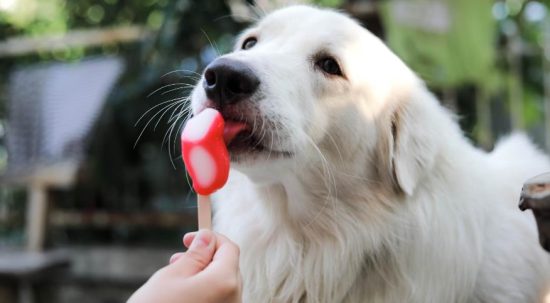What Do I Do If My Dog Ate Ice Cream?
Discover what steps to take if your pup indulges in ice cream, along with safety tips and advice for this common pet concern.

If your dog has managed to sneak a taste of your ice cream, you may be surprised to learn that this common scenario can be more than just a harmless indulgence. In fact, dogs eating ice cream can pose several risks to their health that every pet owner should be aware of. So, what should you do if your furry friend has consumed this frozen treat? This section will provide you with valuable guidance on how to handle the situation, including immediate steps to take, monitoring for symptoms, and when to seek professional help.
As much as we love to spoil our dogs, it’s important to remember that not all human foods are safe for them. While dogs eating ice cream may seem harmless at first glance, it can lead to a range of issues that can compromise their well-being. By understanding the risks and knowing what actions to take, you can ensure your dog stays happy and healthy, even in the face of the temptation of ice cream.
Understanding the Risks of Ice Cream for Dogs
When it comes to sharing ice cream with your furry friend, it’s essential to be aware of the potential risks involved. While dogs may find ice cream to be a delicious treat, it can have adverse effects on their health.
Dogs are lactose intolerant, meaning their bodies struggle to break down lactose, a sugar found in dairy products like ice cream. Consuming ice cream can lead to digestive issues such as diarrhea, bloating, gas, and stomach discomfort. Not all ice cream flavors are safe for dogs. Some may contain toxic ingredients that can be harmful to their health. Substances like chocolate, xylitol (a sugar substitute), and caffeine, which are often found in certain ice cream flavors, can be toxic to dogs if ingested.
The Threat of Pancreatitis and Obesity from High-Fat Treats

Ice cream generally has a high-fat content, which can be problematic for dogs. Feeding them high-fat treats like ice cream on a regular basis can increase their risk of developing pancreatitis. This condition involves inflammation of the pancreas and can result in severe abdominal pain, vomiting, loss of appetite, and even life-threatening complications. Additionally, the excessive consumption of high-fat treats like ice cream can contribute to obesity in dogs, leading to various health issues.
To ensure the well-being of your furry friend, it’s essential to understand the risks associated with feeding them ice cream. Considering alternative, dog-friendly treats and adopting a balanced diet will go a long way in maintaining their health and happiness.
What Do I Do If My Dog Ate Ice Cream?
Discovering that your dog has ingested ice cream can be concerning, but there are immediate steps you can take to ensure their well-being. By assessing the amount and type of ice cream consumed, monitoring for symptoms of dietary distress, and knowing when to contact your veterinarian, you can provide the necessary care for your four-legged friend.
Assessing the Amount and Type of Ice Cream Consumed

Upon discovering that your dog has eaten ice cream, it’s important to assess the quantity and flavor consumed. If they only had a small lick or a small amount, they may not experience significant issues. However, if your dog has consumed a large amount or a flavor that contains toxic ingredients, such as chocolate or xylitol, you should proceed with caution.
Monitoring for Symptoms of Dietary Distress
After your dog ingests ice cream, it’s essential to monitor them closely for any signs of dietary distress. Keep an eye out for symptoms such as vomiting, diarrhea, excessive drooling, changes in appetite, or behavioral changes. If your dog exhibits any of these symptoms, it may be an indication of an adverse reaction to the ice cream.
When to Contact Your Veterinarian
If your dog shows severe symptoms after ingesting ice cream or if you suspect they may have consumed a large quantity or a flavor with toxic ingredients, it’s crucial to contact your veterinarian immediately. They will be able to provide guidance on the next steps to ensure your dog’s safety and well-being.
Remember, every dog is unique, and their reaction to ingesting ice cream may vary. It’s important to keep a watchful eye on your furry companion and take appropriate action if you suspect any issues. By taking prompt and diligent steps, you can help keep your dog safe and healthy.
Recognizing Symptoms: Will My Dog Be OK After Eating Ice Cream?

The enjoyment of a creamy scoop of ice cream can quickly turn into concern when it comes to your furry friend. If your dog has indulged in this frozen treat, it’s important to be aware of potential symptoms that may arise. Recognizing these symptoms can help you determine if your dog will be okay after eating ice cream or if further action is needed to safeguard their health.
Some of the signs that your dog may experience after consuming ice cream include:
- Dogs may exhibit symptoms such as vomiting and diarrhea.
- Your dog might seem unusually tired or lack energy.
- Ice cream can be dehydrating, leading to increased thirst and more frequent urination.
- Your dog may display unusual behavior, such as restlessness or agitation.
While these symptoms can result from a harmless reaction to the ice cream, they could also indicate more serious issues. It’s essential to monitor your dog closely and look out for additional signs of distress, such as difficulty breathing, bloating, or pale gums.
If you notice any concerning symptoms or the situation worsens, it’s crucial to contact your veterinarian immediately for guidance. They can provide the necessary advice and recommend appropriate steps to ensure your dog’s well-being.
What Happens if a Dog Eats Vanilla Ice Cream?
When it comes to dogs and vanilla ice cream, it’s important to be aware of the potential risks involved. While vanilla flavoring may seem harmless, certain components of this popular ice cream flavor can pose dangers to our furry friends. By understanding the distinction between safe and dangerous ingredients and assessing the impact of vanilla flavor on canine health, you can make informed choices for your beloved pet.
Distinguishing Between Safe and Dangerous Ice Cream Components
Not all ice cream ingredients are safe for dogs, and it’s crucial to be attentive to what goes into the frozen treat. Some common ice cream flavorings, such as chocolate, can be highly toxic to dogs. Artificial sweeteners like xylitol can also cause serious health issues, including liver damage. When feeding your dog vanilla ice cream, make sure it doesn’t contain any harmful ingredients and opt for a plain, vanilla-flavored ice cream made specifically for dogs, if available.
Assessing the Impact of Vanilla Flavor on Canine Health
While vanilla itself is not toxic to dogs, it’s important to consider the potential impact of this flavor on your pet’s health. Dogs have different tolerance levels for various foods, and some may have sensitivities or allergies to vanilla. Additionally, the high sugar and fat content of vanilla ice cream can contribute to weight gain, obesity, and other health issues in dogs. It’s always recommended to consult with your veterinarian before introducing new foods or treats into your dog’s diet to ensure their overall well-being.
Table: Comparison of Safe and Dangerous Components in Vanilla Ice Cream
| Safe Components | Dangerous Components |
|---|---|
| Plain vanilla flavoring | Chocolate |
| Plain, dog-friendly vanilla ice cream | Xylitol (artificial sweetener) |
| Caffeine |
By being mindful of the potential risks and taking appropriate precautions, you can safely enjoy vanilla ice cream with your dog. However, it’s always best to consult with your veterinarian regarding your specific dog’s dietary needs and any potential concerns related to vanilla ice cream or other treats.
Alternative Treats: Safe and Delicious Options for Your Dog
While ice cream may not be the best treat for your furry friend, there are plenty of safe and delicious alternatives that you can offer to your beloved dog. These options are not only enjoyable but also healthier and free of the risks associated with ice cream consumption.
One great alternative to traditional ice cream for dogs is frozen fruits. Fruits like bananas, watermelon, and blueberries make refreshing and nutritious treats that dogs love. Simply freeze slices or small pieces of these fruits and offer them to your dog on a hot day. Not only will they satisfy your dog’s cravings, but they will also provide essential vitamins and minerals.
Another dog-friendly dessert option is yogurt-based treats. Yogurt that is free of artificial sweeteners and added sugars can be a great source of probiotics and calcium for your dog. Freeze plain yogurt in silicone molds or ice cube trays to create bite-sized treats that can be enjoyed by dogs of all sizes. You can also mix yogurt with fruits or peanut butter for added flavor.
If you’re feeling creative, you can even make homemade dog-friendly ice cream. Using ingredients like coconut milk, pureed pumpkin, or peanut butter, you can create a tasty frozen treat that your dog will go crazy for. There are plenty of recipes available online that cater specifically to dogs’ dietary needs, ensuring that they can enjoy a cool and tasty treat without any adverse effects.
By offering these alternatives to ice cream, you can provide your dog with a safe and enjoyable treat that is free of the risks associated with traditional ice cream. Remember to consult with your veterinarian to ensure that any ingredient substitutions or additions align with your dog’s specific dietary requirements.
FAQs on What Do I Do If My Dog Ate Ice Cream?
My dog just ate ice cream, should I be worried?
It depends on the ingredients of the ice cream and the amount consumed. Some ice creams contain ingredients harmful to dogs, such as chocolate or artificial sweeteners like xylitol, which can be toxic. If your dog ingested a small amount of regular vanilla ice cream, they might be okay, but it’s best to monitor them for any adverse reactions.
What are the signs that my dog is having an adverse reaction to ice cream?
Look out for symptoms like vomiting, diarrhea, excessive thirst, lethargy, shaking, or difficulty breathing. If you notice any of these signs, contact your veterinarian immediately.
What should I do if my dog ate ice cream containing chocolate or xylitol?
Chocolate and xylitol are highly toxic to dogs and require immediate veterinary attention. Don’t wait for symptoms to appear; contact your vet or an emergency animal hospital right away.
Can I give my dog any type of ice cream as a treat?
It’s best to avoid giving your dog ice cream altogether, especially varieties meant for human consumption. Instead, look for specially formulated dog-friendly frozen treats available at pet stores.
What should I do if my dog ate a large amount of ice cream?
If your dog consumed a large amount of ice cream, regardless of the ingredients, it’s a good idea to contact your veterinarian. They can assess the situation and provide guidance based on your dog’s size, health, and the specific ice cream ingredients.
How can I prevent my dog from eating ice cream in the future?
Keep ice cream and other human treats out of reach of your dog. Train them to respond to commands like “leave it” or “drop it” to discourage them from picking up harmful foods. Additionally, consider offering safe, dog-friendly alternatives as treats instead.





